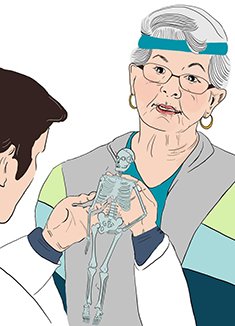PhD defence: The osteogenic stimulus of exercise
Bone health and osteoporosis risk assessment in women
Rizky Suganda Prawiradilaga
PhD thesis
Osteoporosis has become a major global concern for public health. It affects 200 million females globally and is estimated to cause over 8.9 million fractures annually. This condition is characterized by low bone mass and bone tissue damage, resulting in increased bone fragility and risk of fracture.
The aim of the present Ph.D. thesis was to investigate the osteogenic stimulus of exercise and training for women and to contribute to the development of knowledge-based training recommendations for the prevention of bone loss and related bone fractures. The acute response of biochemical bone turnover markers (BTM) to three high-impact jumps and the longitudinal response to 19-week multimodal training for postmenopausal women were investigated. In addition, the relevance of including the measurement of BMD in reliable fracture risk assessment (FRAX) for women diagnosed with early nonmetastatic breast cancer was investigated.
An important finding from the acute cross-over study was a highly significant association between the three-dimensional ground reaction forces (GRF) produced by jumping and the acute BTM response. Thus, it must be recommended to include movements in various directions (odd-impact exercise) when planning osteogenic training.
In the longitudinal training study, which was performed as a health promotional training initiative in a local community, the osteogenic effect was astonishing sparse, no matter whether the osteogenic effect was evaluated by DXA-scanning or by BTM. It is hypothesised that it may be due to the study design, which was limited by a relatively low statistical power and a suboptimal control of the individual training intensity, frequency, and volume.
The evaluation of the FRAX risk assessment instrument showed that inclusion of BMD in the calculation of the 10-year probability of hip fracture or major osteoporotic fracture for women diagnosed with early nonmetastatic breast cancer, is important to avoid overestimation of risk, which could lead to overtreatment.
2020, 164 pages.
Time
9 December 2020, 10:00
Place
Auditorium 5, HCØ, Universitetsparken 5, 2100 Copenhagen and Digital.
Opponents
Associate Professor Jesper Lundbye-Jensen (chair), Department of Nutrition, Exercise and Sports, University of Copenhagen, Denmark
Professor Robin Daly, Deakin University, School of Exercise & Nutrition Sciences, Australia.
Professor Magni Mohr, University of Southern Denmark, Department of Sports Science and Clinical Biomechanics, Denmark.
Supervisor
Associate Professor Eva Wulff Helge, Department of Nutrition, Exercise and Sports, University of Copenhagen, Denmark.
The thesis is available for inspection at the library, Nørre Allé 51, DK-2200 Copenhagen N.

